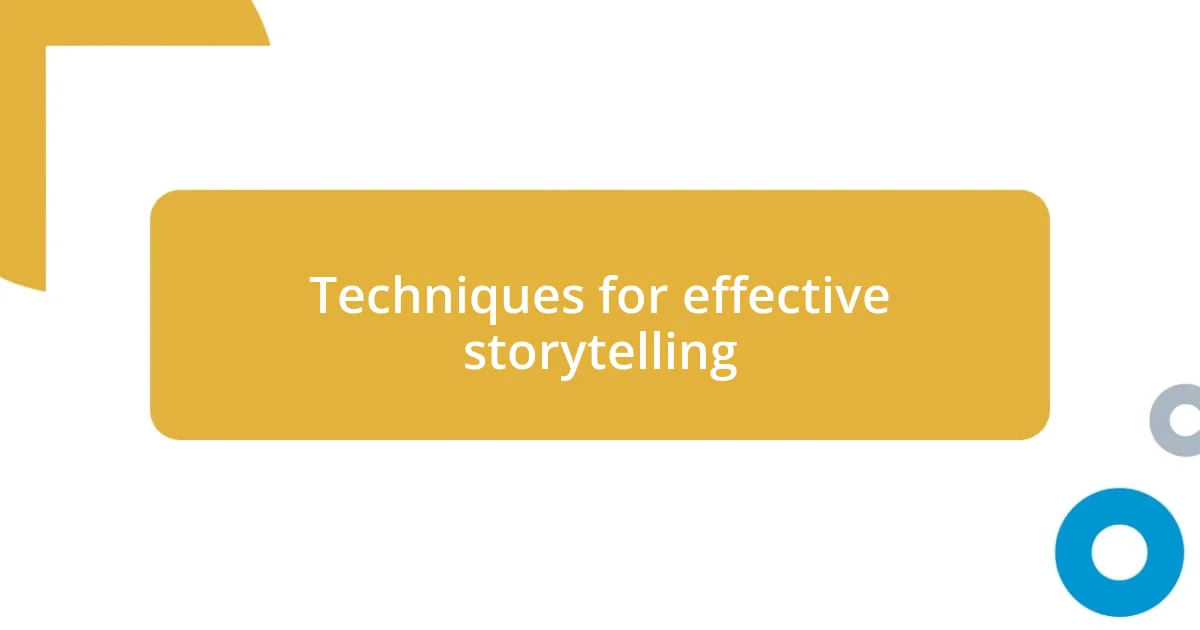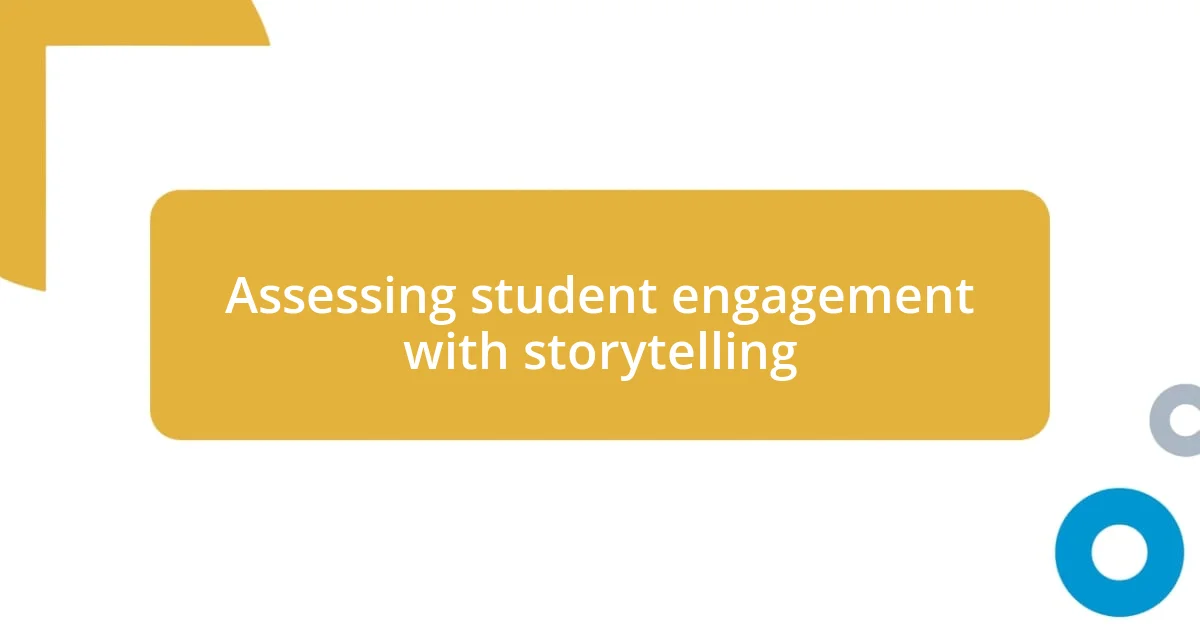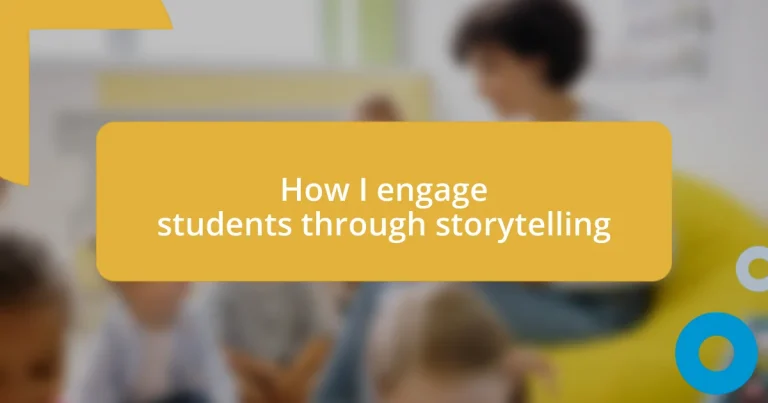Key takeaways:
- Storytelling enhances educational engagement by transforming complex subjects into relatable narratives, fostering emotional connections and curiosity among students.
- Effective storytelling techniques include vivid imagery, strategic pacing, and involving students in the narrative, which helps maintain interest and encourages critical thinking.
- Assessing student engagement through observation, reflective writing, and discussions can reveal their emotional connections to stories, enriching the overall learning experience.

Understanding the power of storytelling
Storytelling truly serves as a bridge between knowledge and emotional connection. I remember a lesson in which I narrated a historical tale that involved real emotions and dilemmas. As I watched my students lean forward, engaged and thinking, it struck me how stories can transform a seemingly dry subject into something alive.
Have you ever noticed how a well-told story can linger in your mind long after the facts fade away? That’s the magic of storytelling—it creates memorable experiences. I often use personal anecdotes to illustrate complex concepts, and I’ve seen firsthand how relatable stories can spark curiosity and foster deeper understanding. When students see themselves in the narrative, learning becomes more than just an intellectual exercise; it becomes a journey they want to embark on.
Moreover, storytelling ignites empathy and encourages diverse perspectives. I always feel a sense of fulfillment when I share a story from my own life, revealing failures and triumphs. The conversations that emerge are rich with insights, as students bravely share their experiences, fostering a safe space for connection and growth. Who knew that a simple story could weave such powerful bonds in the classroom?

Benefits of storytelling in education
Storytelling enriches education by making complex themes more accessible. When I share stories from my travels or past teaching experiences, I see students’ eyes light up as they connect personal experiences to the lesson. Just last semester, I narrated an adventure to a foreign country where I faced challenges that mirrored the struggles of the characters in our literature unit. This connection not only made the material relatable but also sparked their interest in exploring the world beyond the classroom walls.
Here are the key benefits of storytelling in education:
- Enhances memory retention: Stories create emotional connections that help students remember key concepts and ideas.
- Encourages engagement: The narrative hook draws students in, making them active participants in their learning journey.
- Cultivates empathy: Relating to characters and their experiences fosters understanding of diverse cultures and viewpoints.
- Promotes critical thinking: Analyzing stories encourages students to explore themes, motivations, and moral dilemmas.
- Builds community: Sharing personal stories and fostering conversation develops trust and camaraderie among students, creating a supportive learning environment.

Techniques for effective storytelling
One technique I’ve found particularly effective is the use of vivid imagery in storytelling. When I describe scenes in detail, I invite students to visualize the narrative, making them feel as if they are part of the adventure. For instance, while recounting a story about facing a storm during a hiking trip, I described the icy wind and the towering clouds, which led my students to experience the tension and excitement right alongside me.
Another technique that I’ve often employed is the strategic use of pauses and pacing. I still remember the captivated expressions on my students’ faces when I would intentionally slow down during a pivotal moment in the story. It seems that suspense adds an unpredictable layer that keeps them hanging on to every word, transforming storytelling into a dynamic experience that holds their attention.
Additionally, involving my students by asking them to contribute to the story has proven to be transformative. Once, I invited them to create alternate endings to a classic fable we studied, which not only sparked their creativity but also encouraged discussions about morality and choices. This collaborative approach not only deepens their engagement but also highlights the idea that every story is a shared journey.
| Technique | Description |
|---|---|
| Vivid Imagery | Using descriptive language to create mental pictures. |
| Pausing and Pacing | Manipulating the rhythm of storytelling to create suspense. |
| Student Involvement | Encouraging students to contribute to the narrative. |

Choosing the right stories
Choosing the right stories is crucial for engaging students effectively. I often consider the interests and backgrounds of my students when selecting narratives. For instance, I once shared a story about a young immigrant’s journey, which resonated deeply with several students in my class who had similar experiences. This relatability not only captivated them but created an emotional connection that enriched our discussions.
I also believe in the power of thematic relevance. Last year, during a unit on resilience, I recounted my own struggles with a challenging project that went awry. Sharing my vulnerability opened up conversations about overcoming obstacles, and many students shared their stories in return. This mutual exchange created a safe space where we could all explore the theme together, enhancing the learning experience.
When choosing stories, I sometimes ask myself, “Will this story provoke curiosity or empathy?” The right story should spark questions and inspire students to think critically. I remember telling a tale about a local hero—a firefighter who saved lives during a disaster. The ripple effects of that story ignited discussions on heroism, bravery, and even the ethics of sacrifice, prompting students to reflect deeply on their own values. Such stories transform ordinary lessons into extraordinary conversations.

Incorporating visuals in storytelling
Visuals play a crucial role in storytelling, adding layers of engagement that words alone may struggle to convey. I often supplement my narratives with images, maps, or even sketches related to the story. For example, while sharing a tale about an ancient civilization, I displayed a map of their territory, allowing students to visualize not just the locations but the culture and people inhabiting those spaces. It instantly sparked their curiosity, prompting questions about daily life back then and how it compares to today.
I also find that using videos can dramatically enhance storytelling. I remember incorporating a short documentary clip while discussing a historical event. The vivid footage, coupled with personal stories from individuals who lived through it, made the event come alive for my students. Their eyes widened as they witnessed firsthand accounts, and the classroom atmosphere shifted – it became a space buzzing with awe and intrigue. What can be more captivating than seeing a piece of history unfold right before their eyes?
Another strategy I’ve employed is inviting students to create their own visual representations of the stories we explore. When we discussed a novel focused on friendship and loyalty, I encouraged them to make comic strips illustrating key scenes. The moment they saw their ideas come to life on paper was inspiring! I could see their excitement as they shared their interpretations with one another. This visual approach not only deepened their understanding of the themes but also fostered a sense of ownership over the narrative. How could I not feel a sense of pride while witnessing their creativity flourish?

Engaging students through interactive elements
Interactive elements can transform storytelling from a passive experience to an engaging adventure. I vividly remember hosting a storytelling session where students participated as characters in the tale. By assigning roles, they embodied the story, bringing energy and enthusiasm to the classroom. Their laughter and interactions created a lively atmosphere, making the narrative not just mine but ours. Isn’t it fascinating how becoming part of the story can deepen understanding?
One of my favorite techniques is using polls and quizzes during storytelling. I recall one time when I told a suspenseful mystery. At pivotal points, I paused and asked students to predict what would happen next. Their eager guesses turned the lesson into a fun game, and the thrill in the air was palpable. This engagement encouraged critical thinking and sparked great conversations about plot development, reminding me just how powerful student input can be in shaping the narrative.
I also like to incorporate technology, such as interactive storytelling apps, which allow students to explore different outcomes based on their choices. I once used an app with my students that let them navigate a choose-your-own-adventure story. The excitement in their eyes as they made decisions that influenced the outcome was infectious. Seeing them take ownership of the direction of the story emphasized the idea that their voices mattered, and it was a joy to watch their enthusiasm turn into thoughtful discussion afterward. Have you ever seen students so engaged that they forget they’re even in a classroom? It’s moments like these that reaffirm my belief in the power of interactivity in education.

Assessing student engagement with storytelling
Understanding how to assess student engagement with storytelling is crucial for cultivating an effective learning environment. One method that I find particularly illuminating is observing body language and facial expressions during storytelling sessions. I remember one day, as I narrated a heartfelt story about resilience, I noticed how the students leaned forward, their eyes wide with anticipation. Moments like this confirm for me that engagement isn’t just about their words; it’s in their reactions, the unspoken connection they feel with the narrative.
In addition to observation, I frequently use reflective writing assignments to gauge their engagement levels. After sharing a particularly gripping story, I prompted them to write a brief reflection about what resonated with them the most. I was pleasantly surprised by the depth of their responses; students shared personal connections, fears, and hopes inspired by the narrative. This activity not only gave me insight into their engagement but also fostered a deeper understanding of their emotions and perspectives. Doesn’t it feel rewarding when students reveal their inner thoughts through storytelling?
Lastly, I sometimes conduct informal discussions after storytelling sessions. I’ll ask open-ended questions like, “What part of the story did you connect with the most, and why?” The conversations that follow can be incredibly enlightening. I recall a time when a student shared how a character’s struggle mirrored their own experiences. Those moments remind me that storytelling is not merely about relaying facts; it’s about creating a space for students to reflect and relate. How powerful it is when a story ignites such personal connections!














